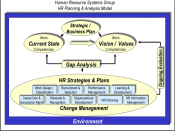Numerous authors have emphasised the importance of integrating the recruitment and selection processes into organizational strategies and HR systems as well as the necessity to respond to changes in the organization's environment (e.g. Stone, 2002, p.174, Nankervis, Compton & McCarthy, 1999, p.190, Compton, Morrissey & Nankervis, 2002, pp.16-17). The organization is constantly changing to respond to changes in its environment, for instance, the structure of the organization may change and jobs redesigned to improve efficiency or reduce costs. However, one of the fundamental mistakes made by management is the failure to allocate "the right people to the right jobs" (Stone, 2002, p.124) once these changes occur. Such "economically" inspired" tactics have been criticised as having a detrimental impact towards the productivity of the workforce and this could be related to the failure in acknowledging the job requirements needed after such fundamental organizational changes have occurred (ACIRRT, 1999, pp.16-17).
As organizations vary in size, aims, functions, complexity, construction, the physical nature of their product, and appeal as employers, so do the contributions of human resource management.
Recruitment and selection is vital to the organization in implementing change and counteracting changes in the environmental context (Stone, 2002, p174). Jobs change accordingly as organizations respond to economic and technological pressures (Nankervis, Compton & McCarthy, 1999, p.190). But, in most the first and ultimate aim of the function is to: "ensure that at all times the business is correctly staffed by the right number of people with the skills relevant to the business needs" that is, neither overstaffed. (Compton, Morrissey & Nankervis, 2002, p.17).
According to the specific request of the personal report, the five key points of Human Resource Management Practice within an organization include human resource planning, recruitment, training, motivation and involvement.
1. HUMAN RESOURCE PLANNING
Human resource planning is usually seen...



Good Info.
Here's some site you can go to":
http://www.un.org/rights/
http://www.hrweb. org/
Thank-you
2 out of 2 people found this comment useful.